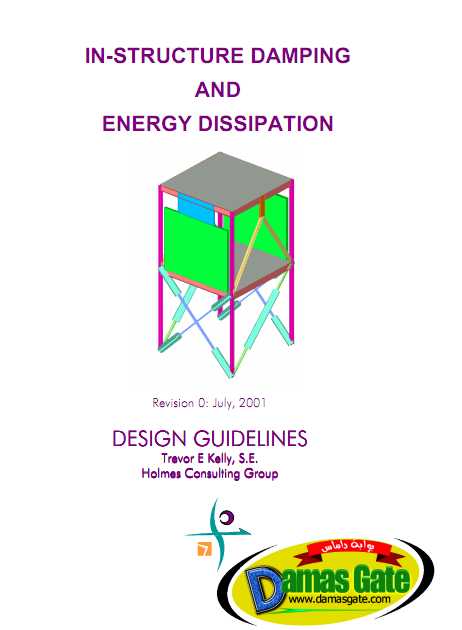In-Structure Damping and Energy Dissipation

1.1 OUR COMPANY INVOLVEMENT
Holmes Group has been involved in the design and supply of base isolation systems for almost 20 years. This
is one form of passive protection for earthquake loads. The other form of passive protection, in-structure
damping and energy dissipation, has not been developed or implemented to the same extent as base isolation
but has applications where isolation is not suitable. This is a potential growth area for the provision of
structural engineering services for earthquake damage mitigation.
To date, we have implemented energy dissipation on one structure, a frame building at the University of
Canterbury was strengthened using yielding brace dampers by the Christchurch office. We have investigated
supplemental damping for a number of other structures but have been hampered by a lack of design
information.
We have a program underway to extend our capabilities in base isolation and performance based design to
incorporate this technology with two aims:
1. To provide damping hardware, through our associated companies, Holmes Devices (which has developed
an improved yielding brace damper) and Holmes Composites (which provides Fyfe Co. visco-elastic
dampers).
2. To establish Holmes Consulting Group and Holmes Culley as recognized experts in providing design
services, analysis services and documentation for projects incorporating in-structure damping and energy
dissipation.
The methodology we are following to achieve these aims requires that we:
1. Become familiar with the latest developments in the technology.
2. Refine our analysis procedures as required to be able to implement promising types of device.
3. Develop design procedures so that we can implement the devices in projects.
4. Provide marketing support to the devices we intend to supply.
The intention is to develop these Design Guidelines into a comprehensive resource containing the full
methodology described in the task list above. This will be a continuing process and so revisions to this
document will be issued as progress is made.
Download
*
Holmes Group has been involved in the design and supply of base isolation systems for almost 20 years. This
is one form of passive protection for earthquake loads. The other form of passive protection, in-structure
damping and energy dissipation, has not been developed or implemented to the same extent as base isolation
but has applications where isolation is not suitable. This is a potential growth area for the provision of
structural engineering services for earthquake damage mitigation.
To date, we have implemented energy dissipation on one structure, a frame building at the University of
Canterbury was strengthened using yielding brace dampers by the Christchurch office. We have investigated
supplemental damping for a number of other structures but have been hampered by a lack of design
information.
We have a program underway to extend our capabilities in base isolation and performance based design to
incorporate this technology with two aims:
1. To provide damping hardware, through our associated companies, Holmes Devices (which has developed
an improved yielding brace damper) and Holmes Composites (which provides Fyfe Co. visco-elastic
dampers).
2. To establish Holmes Consulting Group and Holmes Culley as recognized experts in providing design
services, analysis services and documentation for projects incorporating in-structure damping and energy
dissipation.
The methodology we are following to achieve these aims requires that we:
1. Become familiar with the latest developments in the technology.
2. Refine our analysis procedures as required to be able to implement promising types of device.
3. Develop design procedures so that we can implement the devices in projects.
4. Provide marketing support to the devices we intend to supply.
The intention is to develop these Design Guidelines into a comprehensive resource containing the full
methodology described in the task list above. This will be a continuing process and so revisions to this
document will be issued as progress is made.
Download
*